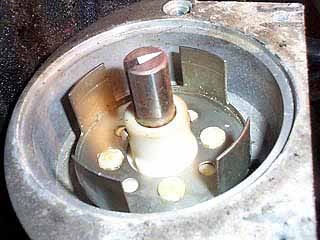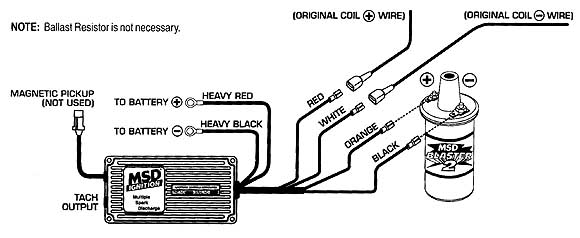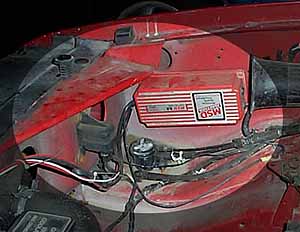
Ignition
systems for FWD Mopars
There are no "real" hidden gains to be found in the stock ignition system, it works and works well for the majority of people! Stock Champion RN12YC spark plugs work excellent; For a colder plug use RN11YC or even colder a RN9YC. I use the RN9YC's myself with no failures or fouling of any kind BUT TBI applications may not like them.
.025 to .035 gap works just fine. In a NON-turbo application a larger gap MAY make a slight increase in power, but you risk a misfire at the high cylinder pressures small displacement turbo engines generate. This is a very important key that people forget. I was at Tri-State dragway in Ohio once and was watching a CSX misfiring like crazy and running high 14's. I went over to check the car out and offer help if needed. The owner had a Mustang friend who had installed an MSD system on the CSX and cranked the spark gap to .045 because "that is what he ran on his Mustang"
Assuming a 302 cubic inch Mustang making a 400 hp under forced induction that's 1.3 hp per cubic inch, or 50 hp per cylinder. Assuming the 2.2 (135 cubic inch displacement) is cranking out 250 hp, that's 1.85 hp per cubic inch or 62.5 hp per cylinder! The four cylinder has drastically higher cylinder pressure per cylinder then the V8 in the above example. The Mustangs ignition system has to work less since the hp is distributed among four more cylinders. The CSX owner dropped his gap down to .030 and the car was running low 13's/high 12's.
Remember a small spark is better then none! Don't get into the mentality that you are losing hp running a smaller gap, you will lose far more power when the misfiring starts. Start at the factory .035 gap and work from there.
The stock ignition coil works great *if* it is in good condition- the early oil filled "can" coil is better then the later model resin filled unit which is mounted on the thermostat housing. If your looking for an upgrade, the MSD Blaster II or III seem to be compatible with production electronics. Some folks in the field have reported failed ignition drivers running the Blaster coils, but after years of testing I have been unable to reproduce the problem.
Chrysler Engineer Dave Zelkowski had this to say about aftermarket ignition systems-
"The ONLY thing they will do for you is lighten your wallet. If there is nothing wrong with the stock ignition components it won't help. If you have some old tired components then it could be a benefit. (This is a key phrase to take note of, 20 year old pieces will have lost some function) I've been through this aftermarket ignition thing before. I spent a week on the dyno with the Super Touring 2.0L testing five different systems whose manufacturer's claimed big results. I found zero. The down side to their systems were that the complexity was increased and they weighed more. The Dodge Super Touring Stratus uses a stock ignition system and a stock engine controller and makes 300hp normally aspirated."
Cap and rotor? I have had no problems with Blue Streak products from Standard, which are made from very high grade materials. On the other hand I have had crossfire issues with several black cap & rotor units on the market made from cheaper materials.

Be aware in the base of 2.2/2.5 distributors there is a plastic disc that holds the pickup shutter wheel in place. They tend to loosen with age and will cause your car to misfire and idle poor, always a good idea to check it when doing a tune up...
If you must use aftermarket plug wires, get Magnacore wires or make a set from a Moroso spiral core universal set.
Do NOT use solid
core wires! modern computers do not tolerate the
electronic noise
they generate!
MSD Systems
At some point you are going to make enough cylinder pressure that a conventional induction ignition system is going to fail. It won't matter how good your wires are, or how fresh the plugs or how powerful the coil. In general there is no hard and fast rule at where this point is as it will vary with power level, hardware configuration and how well the car is tuned. I was able to run with a stock ignition system well into the 10's at 35 psi but have friends that have been stopped cold at 25 psi in the low 11's! Most cars making less then 325-340 hp will have no need for a capacitive discharge system upgrade.
Still wish to install a better ignition?

I have investigated almost all of the systems on the market and the MSD product line seems to have the best blend of functionality and reliability. My suggestion for those looking to run a system to to buy an MSD 6-A or 6-AL system with a Blaster II or III coil. The 6-A box has your basic CD circuitry with no rev limiter, the 6-AL comes with soft touch rev limiting and the ability to hook up other MSD RPM triggered devices.
In either case what the rev limiter is set to in the computers calibration is going to be the defining factor on how high you can rev- Setting the MSD 6AL system to 8000 rpm cutoff isn't going to do any good if the computer is cutting the ignition signal to the box at 6640! Hence why the 6A system maybe a good choice for most people looking for basic CD ignition since it has no rev limiter built in. The 6AL would be a better choice for those looking for a 2 step limiter for launch/burnout reasons or even a valet mode ;-)
Some tips when hooking up the MSD systems-
1) No ballast resistor is required.
2) Remove the noise suppressor that was attached to the old coil and toss it.
3) To get the most out of CD system don't use a stock coil.
Hook up your box JUST like it shows in the diagram above, hooking the box to a "key on" power supply will give you a car that won't run since almost all the fused key on power supply on FWD Chryslers shut down during cranking!
Looking for more ignition power? The MSD 7-AL2 combined with a HVC I or II coil is one of *THE* most powerful systems MSD sells. The Digital 6 or 7 systems are heavy on bells and whistles, but short on the amount of amps they can kick out compared to the 7AL-2.
A warning in regards to the MSD BTM6 ignition system (dial-a-boost retard); they have been tried on our turbo applications and in almost all cases the car ran slower! Let's look how the system works- You have an adjustment knob that allows you to set the amount of retard from 0-3 degrees per pound of boost. Even if it's set at 1 degree, at 14 psi of engine boost the unit will be sucking 14 degrees of timing out of the engine! What's wrong with this? The production electronics are already doing it! So on top of the factory ECU pulling timing out under boost, the MSD unit will be too! The BTM6 system was designed for naturally aspirated engines that have been converted to forced induction, not production turbo cars that already have the boost retard feature programmed into their electronics.

Derek Beland has a MSD-6 system and coil on his 92 TBI car and he seems to like it- Said it make s a big difference at least in his application. You can read more about his impressions here. Using the complete MSD system takes the load off the coil driver in the ECU so there *shouldn't* be any chance of the driver failing.
Platinum spark plugs (Bosch, Autolight, etc...) They fall apart, opps! & Accel coils, any of them. Platinum plugs were primarily developed for long installed life, no high performance.
SplitFire plugs don't
seem to have any effect on our cars at all, except your wallet is $20 lighter
of course,,, I have heard reports of them slowing down cars with the fast burn
head because they disrupt the swirl effect of the cylinder head. Ford engineers
did a study of them a few years back and came to the conclusion that
Splitfire had found way to get the public to pay for plugs at $5 a pop.
Bracket racer Angelo Taylor writes in...
...I NEVER had luck
with Splitfires or Bosch Platinums...
...nothing wrong
with stock Champions.
I have to agree with Angelo on this- My Reliant throws down 10 second passes using Champions with no problems.
Reading Spark
Plugs by Gus Mahon..
Reading
Spark Plugs: Mild detonation, that you might not hear, is evidenced
by small "salt & pepper" specks on the center electrode insulator.
(white porcelain) They're tiny specks; the light ones ("salt") are tiny
molten droplets of aluminum that have hit your insulator, then cooled off
and hardened on it. The dark specks ("pepper") are carbon specks that have
been blasted off of the cylinder head and piston top.
Another
common bad sign is a slight rounding of the edges of the plug's electrodes.
The corners of the electrodes should be sharp 90 degree angles, not rounded.
This is actually a sign of leaning out, but leaning out leads to detonation.
If your plugs are OLD, this is normal. But if you put in fresh plugs, and
a few passes later they're slightly rounded at some corners, you're too
lean. These signs beg for more fuel, and/or less timing advance,
and/or less boost.
Ever wonder
how even your fuel distribution is, but can't tell by the white center
insulators, because of today's unleaded gas? Just throw a little 104+ octane
booster in your tank and drive around for a while. You will then have a
reddish residue on your plugs. The reddest ones are getting the most fuel.
The whitest ones are the leanest cylinders.